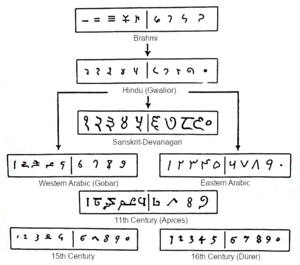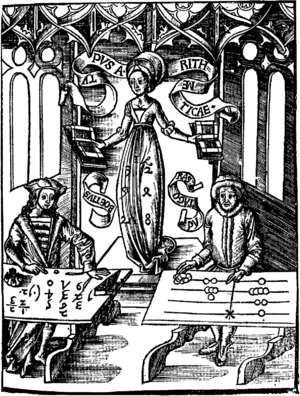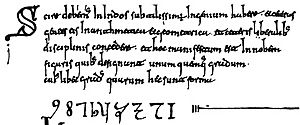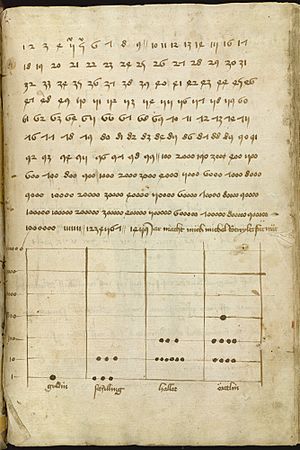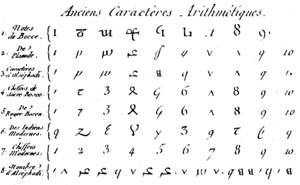Arabic numerals facts for kids
Quick facts for kids Numeral systems by culture |
|
|---|---|
| Hindu–Arabic numerals | |
| Western Arabic Eastern Arabic Khmer |
Indian family Brahmi Thai |
| East Asian numerals | |
| Chinese Suzhou Counting rods |
Japanese Korean |
| Alphabetic numerals | |
| Abjad Armenian Cyrillic Ge'ez |
Hebrew Greek (Ionian) Āryabhaṭa |
| Other systems | |
| Attic Babylonian Egyptian Etruscan |
Mayan Roman Urnfield |
| List of numeral system topics | |
| Positional systems by base | |
| Decimal (10) | |
| 2, 4, 8, 16, 32, 64 | |
| 1, 3, 9, 12, 20, 24, 30, 36, 60, more… | |
The Arabic numerals are the ten symbols we use every day to write numbers: 0, 1, 2, 3, 4, 5, 6, 7, 8, and 9. These are the most common way to write numbers around the world.
When we talk about Arabic numerals, we often mean a system where the position of a digit changes its value. For example, in the number 123, the '1' means 100, the '2' means 20, and the '3' means 3. This is called a positional notation system. We also usually mean a system that uses a base of ten, which is called the decimal system. This is different from older systems like Roman numerals, where symbols like 'I' (1), 'V' (5), and 'X' (10) are combined differently.
These numerals are also known by other names, such as Western Arabic numerals, Hindu–Arabic numerals, or European digits. Even though they are called "Arabic numerals," they actually started in India.
Europeans first learned about these numerals around the 10th century. However, it took a long time for them to become widely used. About 200 years later, an Italian scholar named Fibonacci learned about them in Algeria. His book, Liber Abaci, written in the 13th century, was very important in spreading knowledge of these numbers across Europe. But they were mostly used in Northern Italy until the printing press was invented in the 15th century. After that, European trade and books helped these numerals become popular all over the world. Today, they are used in many countries, even where other number systems like Chinese numerals or Japanese numerals were used before.
History
Where they came from
The idea of using a zero and a positional notation system (where a digit's place matters) was first developed in India. The symbols used in India looked different from the Arabic numerals we use today. As this idea spread, the symbols changed in different regions.
The numbers we call "Arabic numerals" were brought to Europe in the 10th century by Arabic speakers from Spain and North Africa. At that time, these digits were used from Libya to Morocco. In the eastern part of the Arabian Peninsula, people used different symbols called Eastern Arabic numerals, which look like this: ٠, ١, ٢, ٣, ٤, ٥, ٦, ٧, ٨, ٩.
In the early 11th century, a writer named Al-Nasawi noted that mathematicians didn't all agree on how the numbers should look. But most agreed on the forms now known as Eastern Arabic numerals. The oldest examples of written numerals we have are from Egypt, dating back to 873–874 AD. They show different ways of writing the numbers '2' and '3'. These differences show how the Western Arabic numerals (the ones we use) and Eastern Arabic numerals started to look different. Western Arabic numerals became common in North Africa and Spain from the 10th century onwards.
People originally did calculations using a "dust board." They would write numbers with a stylus and then erase them. This is why in the west, this way of calculating was called "calculation with dust." The numbers themselves were sometimes called "dust figures." Later, Al-Uqlidisi invented a way to calculate with ink and paper, without needing a board or erasing.
There's a common story that these number symbols were designed to show their value by the number of angles they had. For example, '1' would have one angle, '2' would have two, and so on. However, there is no proof of this, and it doesn't really work for numbers higher than 4.
How they spread
The first time numbers from 1 to 9 appeared in the West was in a book called the Codex Vigilanus in Spain in 976. This book was a collection of historical documents. Other writings show that numbers from 1 to 9 sometimes had a placeholder, like a circle, which was an early form of zero. The Arabic word for zero is sifr, which became the English word cipher.
From the 980s, Gerbert of Aurillac (who later became Pope Sylvester II) helped spread knowledge of these numbers in Europe. Gerbert had studied in Spain when he was young.
Arabic numerals were not quickly accepted in the West. Other number systems, including the old Roman numerals, were still used. The first people to use Arabic numerals in their writings were astronomers and astrologers. This happened in Bavaria in the mid-12th century. For example, Reinher of Paderborn used them in his tables to calculate the dates of Easter more easily.
Italy
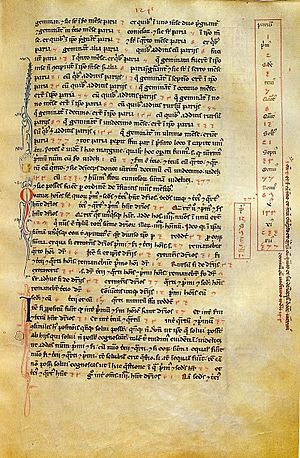
Leonardo Fibonacci was a mathematician from Pisa, Italy. He had studied in Algeria and worked hard to promote the Arabic numeral system in Europe. He did this with his book Liber Abaci in 1202. He wrote: "When my father... was in charge, he summoned me to him while I was still a child... he desired me to stay there and receive instruction in the school of accounting. There, when I had been introduced to the art of the Indians' nine symbols through remarkable teaching, knowledge of the art very soon pleased me above all else and I came to understand it."
Fibonacci's book showed how useful the positional notation system was. His use of these numbers helped them become widely used in Europe. His work came at a time when trade was growing quickly in Italy. Positional notation made it easier to do complex calculations, like changing money, much faster than with the Roman system. It also allowed for larger numbers and made it easier to check your work. Italian merchants in the Middle Ages didn't stop using Roman numerals completely, but they added Arabic numerals to their methods.
Europe
By the late 14th century, not many texts outside Italy used Arabic numerals. This suggests that using Arabic numerals for business, and the benefits they offered, was mostly an Italian secret until the late 15th century. This might have been because of language differences. Even though Fibonacci's Liber Abaci was in Latin, many Italian accounting books were in Italian. This made it hard for non-Italian bankers to learn about them.
The invention of the printing press helped speed up the acceptance of these numerals in Europe. They became widely known during the 15th century. Their use grew steadily in other important places for money and trade, like Lyon. Early examples of their use in Britain include: a clock part from 1396, an inscription on a church tower in Sussex from 1445, and an inscription on a church door in Berkshire from 1448. In central Europe, the King of Hungary Ladislaus the Posthumous started using Arabic numerals in royal documents in 1456.
By the mid-16th century, they were commonly used in most of Europe. Roman numerals were still sometimes used for writing years (like "A.D.") and on clock faces.
Russia
Before Arabic numerals, Russia and other Slavic countries used Cyrillic numerals. These numbers came from the Cyrillic alphabet. This system was used in Russia until the early 18th century. However, Peter the Great officially replaced it with Arabic numerals in 1699.
Peter the Great's decision was likely for several reasons. Russian merchants, soldiers, and officials were increasingly meeting people from Western countries and saw how commonly Arabic numerals were used. Peter also secretly traveled through Northern Europe from 1697 to 1698 and probably learned about Western mathematics during this time. The Cyrillic system was not good for calculating things like the path of artillery shells. It was hard to keep up with the growing field of ballistics using Cyrillic numbers, while Western mathematicians had been publishing on the topic since 1614 using Arabic numerals.
China

The Chinese Shang dynasty had their own number system from the 14th century B.C. This was over 1000 years before the Indian Brahmi numerals. The Shang dynasty system was also based on ten and used positional notation, similar to modern Arabic numerals.
While China had its own positional number systems, like the counting rod system and Suzhou numerals, the Arabic numeral system was eventually brought to medieval China by the Hui people. In the early 17th century, European-style Arabic numerals were introduced by Spanish and Portuguese Jesuits.
Encoding
The ten Arabic numerals are used in almost every way we send information, like Morse code and computer systems. They are stored in computer code like ASCII and Unicode. This makes it easy for computers to understand and use numbers.
See also
 In Spanish: Cifras arábigas para niños
In Spanish: Cifras arábigas para niños
- Arabic numeral variations
- Regional variations in modern handwritten Arabic numerals
- Seven-segment display
- Text figures


